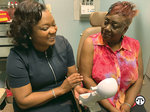

(NAPSI)—Two of the more common eye-related problems are dry eyes and eye allergies. While the symptoms are similar, there are differences between the two conditions. Sometimes they can occur at the same time, compounding the problem.
That’s why it’s important to have a medical eye exam to determine the cause of your symptoms so you can get the appropriate treatment. If you’re concerned about the cost of the exam, the American Academy of Ophthalmology’s EyeCare America program may be able to help.
Understanding Allergies
Seasonal eye allergy symptoms are like dry eye, but itchiness is more common. When you’re sensitive to an allergen such as molds, pollen, dust or grass, histamine is released, causing itchy, red eyes that tear or burn. Over-the-counter medications are often effective. You can also take the following steps for relief:
• Limit exposure to the outdoors on high−pollen count days.
• Wash your face and hands after being outside to reduce the amount of pollen on the skin.
• Don’t rub your eyes; it may increase the irritants and make symptoms worse.
Examining Dry Eye
Dry eye is a complex disease that has many causes that often overlap and interact. Dry eye can happen when the eye doesn’t produce enough tears or when the quality of the tears can’t keep the surface of the eye adequately lubricated. It frequently occurs with other health conditions.
People tend to make fewer tears as they get older due to hormonal changes. Both men and women can get dry eye. However, it is more common in women—especially after menopause.
Common symptoms of dry eye disease may include sensitivity to light, dryness and itchiness, the feeling that something is in the eye, fluctuating vision, eye fatigue and excess eye watering.
Ophthalmologists—physicians specializing in medical and surgical eye care—will prescribe a variety of treatments based on the cause of the dry eye. For many people, though, a few simple lifestyle changes can resolve the problem:
• Try adding moisture to the air with a humidifier.
• Protect your eyes from drying wind by wearing wraparound glasses outside.
• Add omega-3 fatty acids to your diet for dry eye relief. These are in oily fish (such as salmon, sardines, tuna, trout and anchovies) and in flaxseeds.
• Use artificial tear ointment or thick eyedrops just before you go to bed.
If your eyes remain red and irritated after trying these tips, see your ophthalmologist.
About EyeCare America
EyeCare America is a national public service program that provides eye care through volunteer ophthalmologists for seniors 65 and older, and those at increased risk for eye disease. To see if you or your loved ones are eligible, visit www.aao.org/eyecareamerica.
Since 1985, EyeCare America has helped more than 2 million people with sight-saving eye care and resources, and more than 90 percent of the care provided is at no out-of-pocket cost to the patient. The program is co-sponsored by the Knights Templar Eye Foundation, Inc., with additional support provided by Alcon and Regeneron.
<![if !supportLineBreakNewLine]>
<![endif]>
Download high-resolution, print_quality graphic and MS Word document